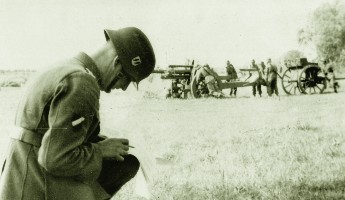
70 years ago on the bank of the River Velikaya, south-east from Ostrov, battles began in which for the first time during World War II both largest units of the Latvian Legion fought shoulder to shoulder — 15th division and 2nd brigade (later renamed as 19th division).
In the battles of 16-18 March, 1944, which took place only 40 kilometres to the East from the border of Latvia, Latvians managed to overpower the resistance of the enemy and to seize the strategically important highland "93.4".
In order to commemorate and honour the victims of this battle and other battles, in 1952 the Central Board of the organisation of the Latvian soldiers "Daugavas Vanagi" adopted a decision to declare 16 March as the Remembrance Day of the Latvian Legion.
March 16 for Latvians in exile became the day when former legionnaires together with friends and relatives commemorated the fallen, the missing, the injured, as well as war prisoners. The annual event was organised in all largest Latvian communities where divisions of "Daugavas Vanagi" operated actively. Traditionally a public worship, a church service, a moment of silence, a visit to cemetery, a ceremonial event and a social event were organised on the commemoration day.
Similar traditions appeared also in Latvia since 1990 and until 1998 - the worship in church and procession to the Freedom Monument did not cause broad resonance within the society. However, everything changed in 1998 when in the beginning of March a protest of seniors and resonance created upon breaking up the protest participants, caused a series of events resulting in the gathering of several hundreds of people on 16 March at the Freedom Monument and miscalling legionnaires "fascists" and "murderers".
In the upcoming years these events escalated and gained international resonance. These events still pose crucial questions within the context of the history of the Latvian Legion: Were legionnaires volunteers? Were they Nazi? Did legionnaires participate in holocaust? What were they fighting for?
Were legionnaires volunteers?
An absolute majority of legionnaires were mobilised, even though officially everywhere they were characterised as "volunteers". Thereby the authorities of the German occupation tried to conceal the violation of international laws, because in accordance with the Hague Convention of 1907, the invader is not entitled to call in the inhabitants of the occupied country in its military forces. The principle of voluntary participation for a long period of time was reflected in the names of the legion units — Latvian SS Volunteer Legion, 15th Latvian SS Volunteer Division, 15th Latvian SS Volunteer Artillery Regiment, etc.
From March 1943 until September 1944, five major mobilisation campaigns were held in Latvia. Initially Germans substantiated this campaign with rules about the introduction of a mandatory work obligation in the occupied regions in the East, but later on it referred to the Law of Military Service of Latvia. Overall 110-115 thousand residents of Latvia served in the legion. About a tenth of these people could have been volunteers.
Were they Nazi?
Even though formally the Latvian Legion was under the subordination of the SS organisation and its leader H. Himmler, actually the legion was a regular component of the German military forces that fought against the Red Army in the front. No legionnaire has ever been part of the German National Socialist Workers' Party. None of them was part of the elitist German SS organisation.
In autumn 1946, the International Nuremberg Military Tribunal declared SS as a criminal organisation and found its members guilty in crimes against humanity if they had been aware of the criminal nature of the organisation and participated in crime commitment.
However, at the same time the tribunal acknowledged that those persons who were forced by the country (thus, Germany) to become involved in the SS organisation should not be found guilty, declaring they have not committed any crime. This part of the judgment helped Latvian organisations explain the Western countries actual non-belonging of the Latvian SS division to this organisation. At the end of 1940s, political refugees located in Germany, including soldiers, started travelling to England, Sweden, Australia, and other Western democratic countries.
For a long period of timer the USA hesitated to give such permission, but on 12 September 1950 the US Displaced Persons Commission acknowledged that "Baltic Waffen-SS units (Baltic legions) are regarded as separate units differing from the German SS in terms of the goal, ideology, activity and composition thereof, therefore the committee does not regard it as a movement that would be hostile to the US government". Therefore the green light for the emigration of Latvian legionnaires was given.
Are Latvian legionnaires involved in crimes against humanity?
Throughout its entire existence, the Latvian legion was involved in war activities against the USSR army in the Eastern front. It did not participate in repressive actions against civilians and anti-partisan campaigns. None of the Latvian legionnaires was accused at a court of having committed war crimes that could have been done within the context of the activity of the legion. However, some uncertainties have been caused by the fact that later on 11 police battalions, as well as the tragically known Viktors Arājs SD unit, whose members participated in holocaust, were involved in the legion.
Inflow of these persons in the legion to a certain extent delayed international court institutions to arrange fast arrest of war criminals. The referred to V. Arājs was arrested only in 1975 in Germany. However, there is no basis to declare that the Latvian Legion was related to the war crimes committed by previous military or paramilitary units.
The legion was established approximately a year after the massive murders of Jews in Latvia. The fact that also war criminals were called in the legion does not make the entire legion a criminal unit.
What were they fighting for?
It seems it would be easier to answer the question "What were they fighting against?" They were fighting against the country whose army occupied Latvia in 1940, liquidated its army, imposed repressions against civilians and threatened to occupy it repeatedly.
In the most complicated war conditions Latvians searched for allies and the only possible ally at that time was the Nazi Germany. Latvians, who entered or were called in the German military forces — units of the Latvian Legion - searched for a positive goal in their destiny of a soldier.
Many found it in the dream about free Latvia, despite the fact that it was not linked with reality, because Germany did not speak about autonomy and independence of Latvia willingly, and after the war (in the case of the victory of Germany) the territory of Latvia was intended for Germanification. Of course, there were various reasons for the battle and they could differ for everyone. Nevertheless, in an extreme situation a person tends to presume the desirable as the existent, even if there is only a slight chance for this to come true.
It is possible that the commander, oberführer (senior leader) of the 15th division Ā. Akss characterised the goals of the battle of the Latvian legionnaires most precisely: "They are Latvians and they want an independent Latvian national state. Facing a choice — Germany or Russia [meaning USSR — author's note], they chose Germany. German dominance seemed the lesser evil. Hatred towards Russia was intensified by the occupation of Latvia."
Jānis Tomaševskis,
Head of World War II History Department of the Latvian War Museum
Publication site: Latvian Legion: controversial points



